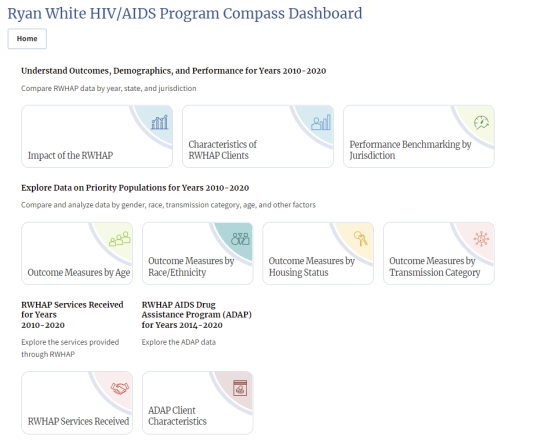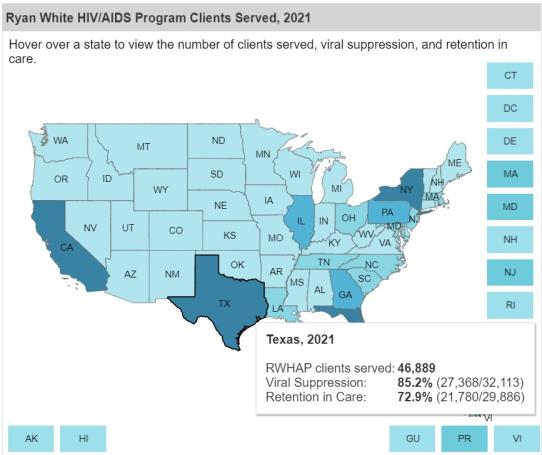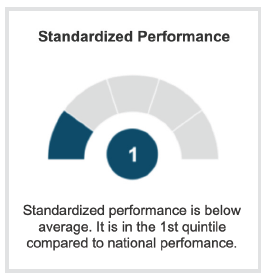
The Ryan White HIV/AIDS Program (RWHAP) Compass Dashboard provides users an opportunity to interact with and visualize the reach, impact, and outcomes of the RWHAP. The Health Resources and Services Administration’s (HRSA) HIV/AIDS Bureau (HAB) developed the dashboard to support data utilization to improve outcomes along the HIV care continuum. By increasing program transparency and users’ ability to interact with RWHAP data for decision making, the dashboard supports HRSA HAB’s vision to provide optimal HIV care and treatment for all to help achieve the Ending the HIV Epidemic in the U.S. (EHE) plan to end the HIV epidemic in the United States.
Download Quick Start Guide (PDF)
Understanding the Data
HRSA HAB’s primary source of annual, client-level data comes from the RWHAP Services Report (RSR), which includes data reported by more than 2,000 RWHAP-funded grant recipients and subrecipients. These de-identified data have been used since 2010 to assess RWHAP client characteristics and HIV-related outcomes. Additionally, AIDS Drug Assistance Program (ADAP) related information, reported through the ADAP Data Report (ADR) since 2014, are also included in the RWHAP Compass Dashboard.
OUTCOME MEASURES
The RWHAP focuses on two primary HIV-related outcome measures — viral suppression and retention in care.
Viral suppression is based on data for people with HIV who had at least one outpatient ambulatory health services (OAHS) visit (i.e., a medical visit) during the measurement calendar year. Among these clients, a client is considered virally suppressed if their last viral load test result in the calendar year was <200 copies/mL.
Retention in care is based on data for people with HIV who had at least one outpatient ambulatory health services visit (i.e., a medical visit) by September 1 of the measurement calendar year. Among these clients, a client is considered retained in care if they had a second visit at least 90 days after.
PERCENTAGE CALCULATIONS
Screens in the dashboard that display the number of clients served (e.g., characteristics of RWHAP clients), include all RWHAP clients, regardless of HIV serostatus. This includes clients with HIV and clients who do not have HIV (i.e., the families of people with HIV are able to receive certain RWHAP services).
Mirroring the Ryan White HIV/AIDS Program Annual Client-Level Data Reports (HRSA HAB’s annual publication of national RWHAP client-level data from the RSR), screens that display outcome measure data (i.e., viral suppression and retention in care) include only people with HIV who also meet the denominator criteria for that specific outcome measure (e.g., people with HIV who had at least one OAHS visit and at least one viral load test during the measurement year). Therefore, these outcomes represent a subset of all RWHAP clients, and the number of people with HIV included in these outcome analyses are less than the total number of people served by the RWHAP. (For more information on outcome measure calculations, see the Technical Notes and Definitions section of the User Guide available on TargetHIV.)
In certain jurisdictions and/or when multiple filters are selected, client populations may be very small. To ensure confidentiality, data are suppressed for small client counts and are not displayed on the dashboard
GEOGRAPHIC REGIONS

The dashboard displays information at national, state, and metropolitan area levels. The boundaries of the Eligible Metropolitan Areas (EMAs) and Transitional Grant Areas (TGAs) are based on the U.S. Census designations of Metropolitan Statistical Areas and may span more than one state.
Selecting a state or metropolitan area will show data for that geographic region, regardless of the funding source. That is, the data represented are not specific to any one RWHAP Part, regardless of the geographic area selected (i.e., state or metropolitan area).
FILTERING DATA
Each screen has a set of filters at the top. Dashboard users can select one or more of these filters to customize the displayed data, including data year and jurisdiction. On certain screens, users can also filter by outcome measure (e.g., viral suppression or retention in care) and/or demographic characteristics of clients served. Users can click the reset button to clear selections and return to the default view.

ABOUT STANDARDIZED PERFORMANCE

RWHAP-funded recipients differ in many important aspects, including the characteristics and various social determinants of health for the clients they serve. The RWHAP Compass Dashboard provides a standardized performance score as a tool to understand relative performance between jurisdictions.
Standardized performance is displayed as a gauge, with scores of one through five. A score of one is in the lowest 20%; a score of three is in the middle 20%; and a score of five is in the top, or highest, 20% of jurisdictions in the U.S. For more information about standardized performance, refer to the Standardized Performance Factsheet available on TargetHIV.
About the HRSA Ryan White HIV/AIDS Program
HRSA’s RWHAP funds states, cities, counties, and local community-based organizations to provide a comprehensive system of HIV primary medical care, essential support services, and medications for low-income people with HIV. HRSA HAB administers the RWHAP and is committed to achieving optimal HIV-related health outcomes for all RWHAP clients.
